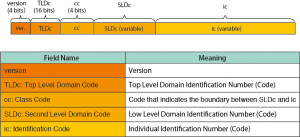What is ucode?
ucode is the identification number assigned to individual objects. In addition, ucodes can be issued for content and information which do not exist in the real world and for more abstract concepts as well as tangible objects and places in the real world. The ucode is a 128-bit fixed length identifier system. Moreover, a mechanism to extend the ucode length in units of 128 bits has been prepared to meet the future demands so codes longer than 128 bits also can be defined. When a ucode is issued for an object or place in the real world, the ucode is stored in a tag (this is called a ucode tag) such as a bar code, a two-dimensional bar code, or an RFID tag.
ucode is simply an identification number. There is no relationship between the number itself and the attribute and meaning of the target to which the ucode was assigned. Ubiquitous ID architecture basically stores information that represents attributes and meaning of the target in databases. The attribute and the meaning can be retrieved from the databases by using the ucode as a key. Since ucode is an identification number, it is essential to guarantee that the uniqueness of issued ucodes is maintained systematically. In other words, multiple targets with the same ucodes assigned shall never exist.
Moreover, when the target of an issued ucode vanishes, the ucode is also revoked. The same ucode shall never be reused later. ucodes attached to vanished subjects are no longer used. Therefore, the uniqueness of a ucode is guaranteed both in space and over time.
In order to make the management (including issue) of ucode easy, a structure consisting of management fields and allocation units illustrated in Figure 1 are defined. However, these are simply a structure for management. The ucode structure does not have a relationship with the attributes and the meaning of the target to which ucode is assigned.
More Detailed Features of ucode
Compared to existing various code systems assigned to objects, ucode has the following features.
- ucode is a code to identify individual objects, unlike existing product code to display product types.
Product codes such as EAN, UCC, and JAN identity the type of product by each vendor. Therefore, for example, the same product code can be assigned to two packages of the same products. However, ucode assigns different numbers to individual packages even if they are the same products. - ucode can be allocated to places, content, and concepts as well as tangible objects.
ucode is the only code system that can identify objects, places, and content universally. - ucode does not depend on application fields and business types.
ucode is not a code system to be tied only to specific industries, for example, logistics. ucode is a code system that can be used for various targets such as electric products, food, places, and music content irrespective of applications and the business types. This is because ucode aims only to identify individual items as objects and places, and is a simple numbering system that does not have any meaning on the target in itself. Therefore, ucode is especially effective for services and item management across industries and applications as well as for services that manage places and objects in the same system. - ucodes do not contain meaning and are simple numbers.
The basic architecture stores information on the attribute and meaning of objects and places on a server in a network. This approach is especially effective for applications where the attribute and meaning of the objects and places to which ucodes are assigned change from moment to moment. Take a guardrail on a road, for example. Guardrails are products produced in a factory until they are delivered to a construction site. When they are installed at the side of a road, they can become parts of the place, components of a scene. After years of use, they are removed. Until they are destroyed, they are industrial wastes. In this manner, even when the meaning (product/place/waste) changes from moment to moment according to the life cycle of a product, the ucode can continue to identify the item in each moment. - ucode is tag-agnostic for storage purposes.
ucodes can be stored in every type of tag such as bar codes, two-dimensional bar codes, RFID and active tags. Therefore, the optimal tag can be selected to store a ucode according to the application and usage environment. - ucode is secure.
Ubiquitous ID architecture, the application framework for handling ucodes, has incorporated eTRON function which is the ubiquitous security framework. Therefore, strong security and privacy information protection can be achieved.


